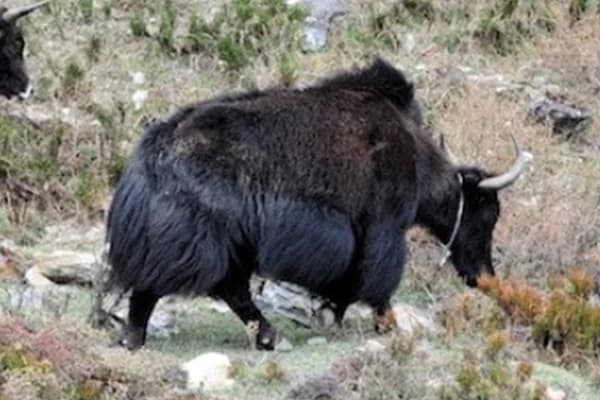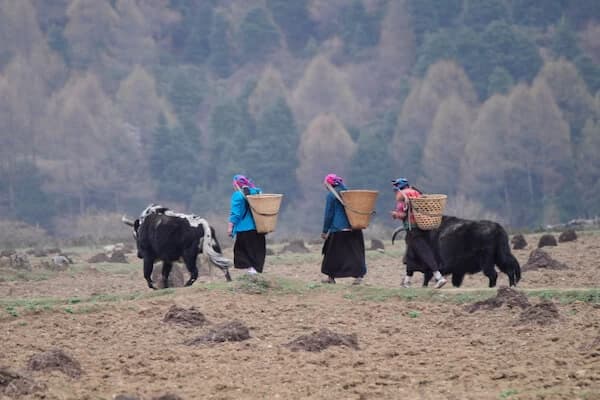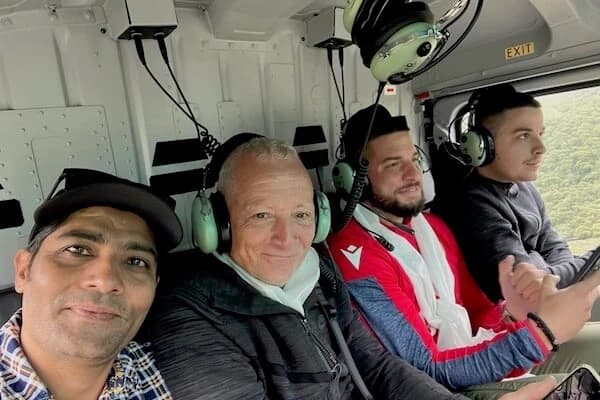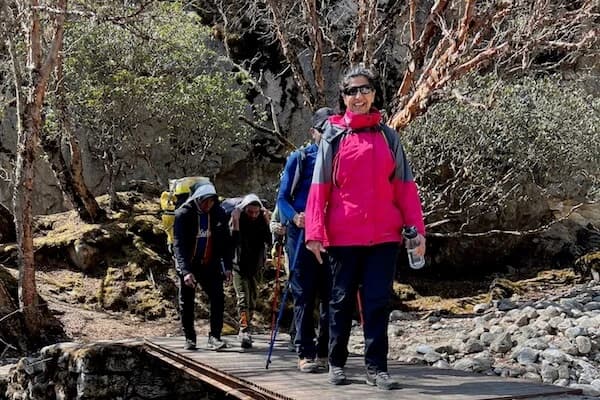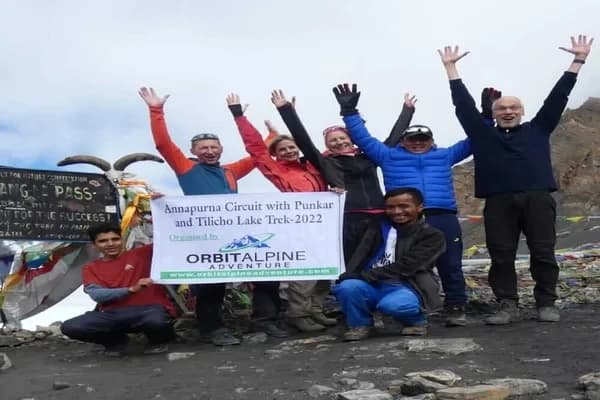Spring (March to May): Peak Trekking Season
For most trekking enthusiasts, the best time to board on a trip to Everest Base Camp (EBC) happens to be in spring. It is during March through May that this season really comes alive in Nepal as the peak months for trekking. The excellent weather, spectacular sceneries, and rich cultural heritage all come together to bring this season up, making it the very sought-after opportunity for adventure-seekers across the globe. Here's a detailed explanation of exactly why spring just happens to be the perfect season for this historic journey.
Weather and Climate: Stable and Mild Conditions
Stable conditions are the hallmark during this spring season that makes it perfect for trekking. March to May is now a period in which temperatures keep on climbing. A maximum of 10°C to 20°C (50°F to 68°F) is achieved during the day at lower elevations. Temperatures and nighttime at higher altitude camps such as Gorakshep and the base camp itself, drop harshly at night and can go to minus 10 degrees centigrade (14 degrees Fahrenheit). However, during the day, it remains quite warm enough to trek in light layers even at higher altitudes.
Another is the slim possibility that it may rain or snow at this time. The mornings can be said to be pretty clear, but clouds begin to pile up by the afternoon. In this season, the weather is pretty predictable, thus allowing hikers to plan their schedule such that they reach their destination before the clouds start forming.
Scenic Views: Rhododendons in Bloom and Vistas of Mountains
Spring: One of the most beautiful sceneries while trekking to Everest Base Camp can be seen when flowers are in full bloom. In spring, the national flower of Nepal, rhododendron, blooms with such a variety that the trekking trails take the form of colorful tapestries of red, pink, and white blossomed colors. Such flourishing forests make the lower alpine sections of the route appear almost magical.
From now on, as you ascend higher, the scenery changes from dense greenery and multicolored forests to the gasping beauty of alpine landscapes, characterized by snow-capped summits. The spring conditions in this zone are excellent and offer a great view,
especially in the mornings. The trekkers are in for some wonderful all-around views of the Everest massif, Lhotse, Nuptse, and Ama Dablam, among several other towering Himalayan giants.
It is also the time when the icefalls and glaciers are at their best, to say the least, and add almost an awe-inspiring sense of grandeur to the trek. Photographers in particular will love this time of the year to capture the beauty of the region.
Everest Climbing Season: Base Camp Activity Hubs
Spring is the season on top but also the prime climbing season on Everest. This is when most expeditions attempt to climb Everest, during which they make their final push. Approaching Everest Base Camp would have been a sea of uproar where climbers were pitching tents, sorting through gear, and preparing for the adventure of a lifetime.
This heightens the trek experience at base camp, which is most happening, and trekkers can witness and exchange their stories with people climbing to Everest Base Camp from across the world. Perhaps due to their firmness and effort, some will be inspirational to them. For many trekkers, it's part of the thrill of visiting Everest Base Camp in spring.
Spring Trekking Advantages
- Best Mountain Views: The spring season offers the clearest skies as well as very minimal water falls. This is the time when it's best to view Everest as well as other giant peaks for visibility, particularly in the mornings
- Stable Weather Conditions: Given mild temperatures by day and conditions that are predictable, spring offers some of the safest and most comforting trekking conditions.
- Flowers: Rhododendron comes in full color on most trails, which makes the scenery more colorful.
- Cultural Exposure: In this period of a year, there are so many festivals going around Nepal, which gives the trekkers the opportunity to share a particular moment in the life of the locals.
- Everest Climbing Period: Sharing the trail with the people who prepare to leave for Everest Climbing also brings excitement and companionship.
Challenges of Trekking in Spring
- Crowds on the Trail: As spring falls in peak trekking time, you can expect crowds of trekkers. You'll most likely find it on the very popular sections of the trail like Namche Bazaar, Tengboche, and Dingboche. The tea houses may fill up quickly, and although this will be filled with social activity, it'll reduce the solitude that some hikers seek.
- ncreasing Costs: The greater the demand, the costlier the flights to Lukla, accommodation, and other facilities. Consequently, advanced booking is the way forward to confirm that preference options are available.
- Temperature Fluctuations: As the days are pleasant, so are the nights, the higher you go. It is, therefore, wise to pack in layers and be prepared for temperature dips.
Tips for Packing while on Spring Trek
Packing for a spring trek needs to strike a balance for managing variable weather conditions that may vary day to night and even by altitude.
Must include:
- Layered clothing: You will need base layers that will be supplemented with fleece and a down jacket for warmth, especially higher up
- Waterproof jacket: While rain is rare, it is indeed some days - in late May, especially - can produce short showers.
- Sunglasses and Sunscreen: The UV rays are too strong at such high altitudes and clear skies of springs safeguard that you will spend hours in the sun.
- Trekking Poles: Sections of trails get muddy, especially at lower elevations so they will aid in balance and ease the pressure on your knees.
Summer/Monsoon (June to August): The Off-Peak Season
Summer treks to Everest Base Camp, which coincides with Nepal's monsoon season in June, July, and August, are at once far removed from the spring and autumn favorite season. Yet, although this may be considered off-peak season because of heavy rainfall and big difficulties while using the trail, there's ample opportunity in search of solitude, lavish sceneries and cheaper costs. Summer/Monsoon season: Here is a great description of what to expect when trekking in that season.
Weather and Climate Wet and Humid Conditions
The trademark of Nepal's summer trekking season is a monsoon, falling heavily across the country. The lower parts of Lukla and Phakding areas experience frequent intensives of it. It heats up at lower altitudes to about 15°C to 25°C or 59°F to 77°F during the day and cools up in higher areas but is relatively much warmer than winter.
As you climb up to higher altitudes up towards Namche Bazaar and further, it becomes drier but still receives those afternoon showers and full cloud cover. The parts closer to Everest Base Camp are relatively drier in comparison to the lower valleys but are foggy and cloudy most of the time.
The daytime temperatures are warmer than any other season, although the humidity can be really fatiguing and the trails get muddy and slippery. Temperatures have been fairly mild at night compared to winter, yet the trekkers should still prepare for cooler temperatures as they ascend to higher altitudes. When approaching high altitudes, they can expect nighttime temperatures to fall close to freezing.
Scenery: Lush greens and impressive waterfalls
The most impressive feature of the rainy season trek is a green landscape at full intensity. The rains transform the lower hills and valleys into a green heaven entirely covered with vegetation. The forests along the trail are full of harmony of birds and gorgeous blooming wildflowers that add freshness to the beauty of the trek.
The rain also feeds the many rivers and waterfalls on the trekking route, which makes them much more powerful and dramatic than at other times of the year. Monsoon also intensifies the scent of earth and vegetation, so this can be described as an experience of senses during this time.
This is, however an ugly side-the mountain views are covered. Most of the times the tall summits of Everest, Lhotse, and Ama Dablam hide behind thick clouds and fog, especially in the afternoons, while the mornings may sometimes provide a brief view but the trekkers have to prepare themselves for taking the possibility of the trekkers trek without seeing the grand majesty of the Himalayan ranges.
Fewer Crowds a Quieter, More Peaceful Trek
Perhaps the greatest advantage of trekking in the monsoon season is solitude. Fewer trekkers fill the spring and autumn seasons compared to this because there are fewer tea houses, quieter campsites, and much more peaceful and personal connection with the surrounding environment.
For those who prefer the experience of the Himalayas away from the crowds of other trekkers, the monsoons are the best season. The stillness of the path is relatively more thoughtful this time of the year, offering trekkers the chance for solitude and natural beauty uninterrupted.
More Economical: A Cheap Trekking Option
Since this is the off-peak period, flight, accommodation and guide service fees are comparatively cheaper compared to the other periods during the spring or autumn. Many tea houses have cut off their prices, and flights to Lukla are cheaper though more likely to be delayed by weather. To budget-conscious trekkers, the monsoon period is a more affordable alternative than peak trekking seasons.
Further, as the guides and porters are easily available at this time you will be receiving good care and customised service at the time of the trekking.
Challenges in the Trek during Monsoon
-
Heavy rainfall with the muddy trails: The most important problem to the trekkers sometimes comes with heavy rains. Heavy rain means dirty and slippery trails that enhance slowing down speed and possibility of slippage and injuries. Some vital things to be worn in this season are high-quality, waterproof hiking shoes and the carrying of some hiking poles for keeping yourself stable.
- Leeches: At lower altitudes the rain situation means that there are leeches everywhere. They are inoffensive to trekkers, but can be a nuisance. Long socks are highly suggested, as is insect repellent to minimize their encounter.
- Poor Mountain Scenic Views: The monsoon season is mostly characterized by frequent covering under clouds. As such, Everest and all other mountain peaks remain mostly hidden in mist. Those who love more open views of mountains will not like this season.
- Flight Delays and Cancellations: Flight to Lukla, where most Everest Base Camp treks start off by usually being delayed in monsoon time because of poor visibility and changeable weather. There should be provision for extra days to accommodate delays in planning.
Packing for Monsoon Trekking
There are specific gears needed to trek in the wet and changeable weather of the rainy season. Some of these must-haves are:
- Waterproof Gear: A good waterproof jacket, pants, and backpack cover will also keep you dry as well as your belongings.
- Quick-Drying Clothing: Pack the lightest, moisture-wicking clothes that dry fast after being wet.
- Trekking Poles: Additional stability on slick trails and relieving some of the weight off your knees during downhill sections.
- Gaiters and Anti-Leech Socks: Gaiters will prevent mud from going into your shoes, and anti-leech socks will ensure no leech inside your clothes.
Golden Season: Autumn (September to November)
Autumn, from September to November, is considered the golden season for trekking to Everest Base Camp. This season offers marvelous stable weather conditions with clear skies, magnificent views, and a charming culture experience for the trekkers. It is one of the busiest periods of the year for trekking in the Himalayas since conditions are nearly perfect for adventure seekers who prefer experiencing the Everest region at its best. Let's see why the autumn period could be an ideal time to carry out this iconic trek.
Weather and Climate: Ideal trekking conditions
Autumn has some of the most stable pleasant weather conditions within the Everest region. The heavy monsoon rains had just ended by early September; the crisp air was clean. This created ideal trekking conditions, clear blue skies, and excellent visibility in the surrounding mountains.
Lower elevations such as Lukla and Namche Bazaar experience daytime temperatures between 10°C to 20°C (50°F to 68°F) while -10°C or below at nights, especially in November. Meanwhile, at times during the day, the weather has little chance of being caused by rainfall or snow.
One other thing – the weather during autumn is so predictable that the trekkers can plan without any doubt on account of sudden storms or sudden temperature swings. The mornings are generally bright and sunny; sometimes, during the afternoon, a bit of sprinkled cloud cover may find its way into the scene, but overall, it remains stable.
Scenery: Crystal Clear Views and Stunning Landscapes
The post-monsoon clarity makes autumn an excellent time for trekking individuals to rejoice in the glory of the Himalayas. The skies are clear, and they get some of the year's best views of the mountains. Wonderful views of high peaks such as the Everest massif, Lhotse, Nuptse, and Ama Dablam are seen by the trekkers.
The scenery in autumn seems to be the most colorful, as monsoon rains have bestowed hills and valleys with moist greens. In the higher mountainous regions, the clearings give away to more rough terrains; however, the wild magnificence of the scenery is awesomely beautiful. The glaciers and ice falls along this trail are picture-perfect and form dramatic scenes of majesty in nature.
Autumn is the season that appears to be the best season to allow photographers to capture all that is seen in sharp and clear images, especially during this period, when mountains appear at their peaks with snow-topped tops and deep blue skies.
Cultural Experiences: Festivals and Local Life
The trek is made richer because autumn is also a major cultural celebration in Nepal. Two most important Hindu festivals, Dashain and Tihar fall in this season giving the trekkers a chance to observe and participate in local traditions and celebrations.
Dashain is the longest and most auspicious festival of Nepal that generally falls in October. It is the festival in which good finally overpowers evil, and family ceremonies along with the flying of kites and animal sacrifices are celebrated. Tihar is often known as the "Festival of Lights" and takes place immediately after Dashain and celebrates mankind's relationship with animals. Villages along the trekking route become like sceneries during these events while the trekker has a sight into the city's energetic life.
This season is also the best for interacting with Sherpa communities along the trail of EBC. The Sherpa people are one of the friendliest communities in the world, but during the fall season, they are specifically warm and inviting to trekkers to learn their culture and hear their stories.
Advantages of Trekking in Autumn
- Ideal Climatic Conditions to Climb: As the weather remains relatively clear and stable, autumn poses the safest and most relaxed time for trekking. The time with moderate temperatures, therefore minimal chances of rain or snow, guarantees perfect conditions to trek.
- Awesome Views of Mountains: With post-monsoon clarity, great views of the Everest range are confirmed for trekkers. Every morning unfolds an incredible vista of the world's highest peaks.
- Cultural Immersion: Autumn coincides with significant religious events in Nepal, which gives trekkers the opportunity to explore decadent traditional systems and local festivals.
- Thriving Ecosystem: During autumn, landscapes offer luxurious covers after the completion of monsoon seasons; therefore, it presents itself as a beautiful scenery for trekking through its lower elevation levels.
Challenges Experienced during Autumn Trekking
- Crowds on the Trail: Peak season for trekking falls during the autumn and attracts crowds from each corner of the world. Pop up villages like Namche Bazaar and Tengboche get pretty crowded, so do the tea houses, hence, it makes sense to book ahead of time.
- Costs will be somewhat steeper since the people in masses are trying to book flights, guides, and accommodation. This is likely to raise a premium especially at the popular lodges.
- November: November weather can be much colder as compared to the same areas that had been having those pleasant and mildly warm September and October days. Nights would turn chilly at higher elevations. Warm clothes should not be lacking at this time of the season.
What to Pack for an Autumn Hike
For autumn hiking, you have to mix in warm and cold gear. For example, you will surely need:
- Multiple layers: Base layer to keep in moisture away from your body as you hike-the key is to be in moisture-wicking garments; a fleece to keep one warm; a down jacket for cold evenings.
- Sun Protection: Even when the weather is a bit cooler, UV rays that are high above are strong, so sunscreen, sunglasses, and a wide-brimmed hat are a must.
- Trekking Poles: These are helpful for the uneven ground and also help to keep weight off your knees for the downhill trails.
- Sleeping Bag: A good-quality sleeping bag rated at temperatures below freezing are in order for the colder nights up at the higher altitudes.
Winter December - February: The Quiet Season
Probably the most neglected trek of the Everest season goes on from December to February. Though quite harsh, what can be a nightmare to some is a peacefulness for an adventurer seeking solitude and beautiful yet snow-covered sceneries without the crowds to disturb a peaceful experience in this season. While the weather and climate are colder and there are fewer daylight hours, these entail a few drawbacks, but the prize is that fewer crowds and clear skies offer awesome scenery, making winter preferable for seasoned trekkers.
Weather and Climate: Cold but Clear
Winters in the Everest region can be really tough, especially higher up. Low-altitude regions, such as Lukla and Phakding, usually experience daytime temperatures ranging from 5 to 10°C (41-50°F). However, you'll know for yourself how this temperature plummets once you continue upwards; nighttime temperatures in Gorakshep and Everest Base Camp were -20°C (-4°F) or below.]
It is at such times that the temperatures are this low that one of the biggest advantages of winter trekking manifests: clear blue skies during the dry winter months. It presents excellent visibility of these giants including Everest, Lhotse, Nuptse, and Ama Dablam, which otherwise are covered by rain in the monsoon and other times of the year. Winter, on the other hand, is credited with delivering sharp views throughout the day more often than any other season.
On the other hand, it has shorter daylight hours; hence, trekkers must be very calculating in preparation for their daily activities and ensure that they reach the supposed destinations before dusk falls. An early morning start is therefore advised in maximum utilization of limited sunlight.
Scenery: Snow-Capped Mountains and Serene Landscape
Winter time in the Everest region has transformed it into a wonderland that has turned into a snow-covered wonderland. All paths, forests, and high-altitude valleys are all covered in the blanket of snow and are unearthly, peaceful environments incomparable to any season. The more dramatic peaks seem this time due to their snow-capped peaks against a clear blue sky.
Snow and beauty is more pronounced at the higher elevations in winter. All the glaciers and icefalls like Khumbu Icefall are seen at their best at this time of the year. Fresh-fallen blanket of snow adds some extra beauty to a spectacular view, and the absence of crowds provides trekkers with an opportunity to get involved in absolute quietness and peacefulness of the environment around.
It is an excellent time for photographers and nature lovers to capture the Everest region in its most unspoiled form.
Less Crowd: Serene Hike Experience
The main attraction of doing the trek in winter is that it's less crowded. The Everest Base Camp trek is very crowded, especially during the peak spring and autumn seasons, because all tea houses get full and trekkers are everywhere on the paths. Winter is quiet and peaceful by comparison.
You're going to see many fewer trekkers on the track, so you can appreciate the beauty of the region without all the hustle and bustle that comes along with other tourists. Tea houses are less crowded, so you're much more likely to get personalized service and even the time to get to know locals. It is a very peaceful time for trekking, and for those looking to experience the Himalayas in the most intimate, least commercialized way, winter becomes an attractive option.
Challenges of Winter Trekking
Despite the fact that the winter season offers so many advantages, it also bears major challenges; hence, one should be highly prepared for such a cold season and other disasters during that particular period.
- Severe Coldness: Of course, extreme coldness is one of the more obvious challenges, which compares to what people encounter at more elevated places. Day temperatures are tolerable, but night temperatures are painfully cold, especially at elevations above 4,000 meters. Proper clothing, including a good sleeping bag and the down jacket, makes a lot of difference.
- Snow and Ice on the Trails: Depending on the melting of snow from warm temperature, it can melt all the way down to trails; thus, making it slippery to trek through. In some instances, it would be necessary to carry trekking poles for the icy sections, especially in passes like Thokla.
- Closed Tea Houses: Though the majority of the tea houses remain open during winter, some in higher altitudes close down during the really cold winter and fewer trekkers. Careful advance planning will have to be taken while planning for the route or trails where, which of the tea houses are open.
- Shorter days: An early start every day is important as the time for daylight is less. It is vital to manage your time and plan ahead so you do not get stuck on the trail in the dark.
Winter Trekking Packing Ideas
Winter conditions demand more specialized gear as cold conditions overcome. While packing for a winter trek to Everest Base Camp, the details have to be taken care of. Some of the necessities are listed below:
- Insulated Clothing: Layering is the key to keeping warm. Take base layers that wick moisture, a fleece or insulated jacket and a good down jacket for extremely cold temperatures.
- Sleeping Bag: A sleeping bag rated -20°C or colder as nights get very cold at higher altitudes.
- Trekking Poles and Crampons: To maintain balance and grip on icy or snowy stretches of trail.
- Thermal Gloves, Socks, and Hat: Keep your extremities warm, and bring along thick thermal gloves, wool socks, and a hat, which should be able to cover your ears.
- Sunglasses and Sunscreen: The sun in the winter and then reflected off the snow can make for incredible glare, so take proper care of your eyes and skin by protecting it from UVs.
Benefits of Trekking in Winter
- Serene and Quiet: With lesser trekkers, going during winter time is more serene and peaceful.
- Breathtaking Views: Dry air during winter brings the clearest skies possible with no obstruction to mountain views.
- Unique Scenes: The heavy snow will cover the Everest region as a winter wonderland bringing pretty much different sceneries from those in other seasons
- Less Expensive: Off-peak season means that flights, accommodations, and guides are less expensive.
Things to Keep in Mind When Choosing the Best Season to Hike
If you're planning to become a first-time trekker, you should consider hiking during the spring and autumn months when the weather is generally warm and pleasing, and the trails are at their best. Our Everest Base Camp preparation tips will help you get ready for the journey step by step. For the seasoned trekkers seeking isolation and some adventure, winter or even monsoon may be ideal.
Weather Conditions
The most important factor while planning a trek to Everest Base Camp is the weather. If one loves clear skies and wonderful mountain views, then spring and autumn seasons are ideal. However, if one can bear the cold or the rain just to be alone in the world, then winter or summer could be ideal.
Crowd Levels
Crowds are at their peak during spring and autumn, and if you like solitude or do not delight in sharing the trail with hundreds of other trekkers, you might want to come during monsoon or winter. Be warned, though, to endure the extra stress these seasons impose.
Costs
Trekking during spring and autumn holidays is relatively expensive because the flights, accommodation, and guide services are in high demand. The two off peak seasons, monsoon and winter, tend to be budget-friendly but present different challenges.
Festivals and Culture
If you have the desire to combine your trekking with cultural viewings then autumn happens to be the best time of year to visit, for the experience of Dashain and Tihar, two Nepal's major festivals. These festivals add another dimension to the trek by letting you stay familiar with local customs and hospitality.
Health and Emergency Considerations
Trekking usually requires good physical condition. If you have problem in your heart, lungs, or knees, it is wise to be cautious. In case of altitude sickness, fatigue, or knee pain that makes descent difficult, you can use Everest Base Camp Trek Return By Helicopter option which is the most safe and convinient option used by many trekkers.
Conclusion
To sum it up, the time to visit Everest Base Camp will depend on what experience you want to have. The most popular seasons are spring (March-May) and autumn (September-November), during which time weather stability and clear skies can be counted upon, resulting in some of the finest trekking and mountain visibility. In this regard, though, comes a huge cost in terms of big crowds on the trail and higher expenses.
Winter-December to February-is less crowded and definitely more peaceful and beautiful with snow-covered landscapes. One does not prefer trekking during the monsoon season, June to August, but it comes with luxurious greenery, fewer crowds, and low prices.
Whatever be the season you take, trekking to Everest Base Camp is a memory-making adventure which offers stunning landscapes, rich culture, and the excitement of being near the world's tallest mountain.
FAQs
1. How difficult is the Everest Base Camp trek?
The EBC trek is moderately difficult. The trek doesn't need any technical climbing skills; however, it consists of long days of walking.
2. Do I hire a guide or porter for the Everest Base Camp trek?
Not necessary but hiring a guide and/or porter would be advisable during Everest Base Camp due to safety and support issues.
3. What are the best months to trek to Everest Base Camp?
Spring is the best time to go trekking to Everest Base Camp, between March and May. One can witness stable weather, clear skies, and excellent mountain views during these periods.
4. How long will it take to complete the Everest Base Camp trek?
The standard Everest Base Camp trek usually takes 12 to 14 days, which contain acclimatization days. Most itineraries allow for 9-10 days of trekking up to base camp and allow for three to four days in descending.
5. What sort of accommodation is available on the Everest Base Camp trek?
Tea houses exist at every point of the EBC and accommodation can be availed at simple lodges that provide basic rooms, usually with twin beds and shared bathrooms.


